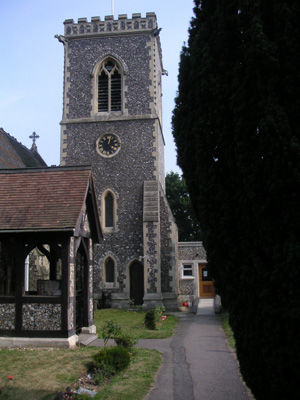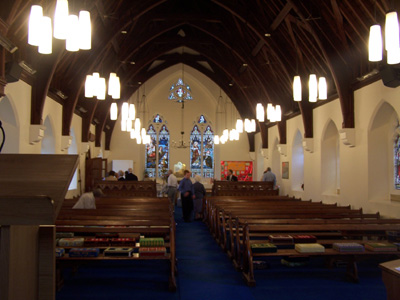 |
||||||||||
 |
||||||||||
|
1174: St Margaret of Antioch, Iver Heath, Buckinghamshire,
England Mystery Worshipper: Liturgist. The church: St Margaret of Antioch, Iver Heath, Buckinghamshire, England. Denomination: Church of England. The building: Dating from 1862, the building is a good impression of a 13th century English parish church, with open faced flintwork walls, a tower beside the church, a lychgate at the entrance, and many graves in the churchyard. A link on the website leads to descriptions and pictures of the stained glass. The church: Both family eucharist and eucharist "with children withdrawn for part of the service" are celebrated, although not both services every Sunday. Each Wednesday, either eucharist or morning prayer is offered. There is also a Bible study group and choir. The neighbourhood: Iver Heath is a small (about 5,000) mostly residential community a few miles west of London with a mix of middle class and very high rent housing. It is also the home of Pinewood Studios, making it a place that almost everyone has heard of although few have seen. The cast: The Rev. Will Hazlewood, priest in charge, was the celebrant and preacher. Several lay assistants were not listed by name, but I later learned that the organist was Ronald Stamp – in his 57th year of service to that parish. The date & time: Sunday, 24 July 2005, 10.00am. What was the name of the service? Holy Communion. How full was the building? About two-thirds full, perhaps 80 people. Did anyone welcome you personally? We received both a greeting and a smile from the person who handed us the prayer book and hymnal. Was your pew comfortable? Well, it wasn't as bad as it looked (a plain bench with a low back), but the needlepoint kneelers were well padded and there was room to kneel easily. How would you describe the pre-service atmosphere? A little quiet chatter in the back, but this was not disturbing. People seemed happy to be there. What were the exact opening words of the service? "Please stand and sing the opening hymn, number 631." What books did the congregation use during the service? We had the Book of Common Prayer (1662) with a few variations, the New English Hymnal, a bulletin including the texts of the readings, and another insert with a form for the thanksgiving for the birth of a child. All of this was handed to us on entering rather than placed in the pews. What musical instruments were played? Organ and choir. Did anything distract you? Since we had a complete printed order of service, I could have done with fewer page announcements. Mrs Liturgist had not experienced the 1662 communion service before and found the different arrangement (compared to the American book) a bit distracting. Was the worship stiff-upper-lip, happy clappy, or what? They describe themselves as modern Catholic and I found the style to be relaxed but with a definite sense of doing it decently and in order. Nearly all of the singing was congregational, led by the choir, and the selections were decidedly traditional.  Exactly how long was the sermon? 9 minutes. On a scale of 1-10, how good was the preacher? 8 – Father Hazelwood spoke clearly and easily without any apparent dependence on notes, and made good eye contact with the congregation. In a nutshell, what was the sermon about? The text was the parable of the treasure hidden in a field, and the preacher started by recalling his early hopes of winning the lottery (which, alas, has never happened). He compared that to the confidence of winning and the value of the treasure that would lead someone to spend everything he had to buy the field. Which part of the service was like being in heaven? It is hard to single out any one thing. The whole service was reverent, with active participation by a congregation that obviously cared about what they were doing. And which part was like being in... er... the other place? I usually find it all too easy to be picky, but there wasn't much for me to find fault with. I'm not especially a fan of 1662 (which they use on alternate Sundays) but would have been interested to see it "pure and unadulterated", though the variations were actually fairly minor. What happened when you hung around after the service looking lost? There was no chance to stand around – we were promptly urged to move to the adjoining parish hall for coffee. How would you describe the after-service coffee? Freshly brewed coffee and tea, served in china cups, with biscuits, in a friendly atmosphere. It wasn't lavish, but very welcoming. How would you feel about making this church your regular (where 10 = ecstatic, 0 = terminal)? 9 – We aren't ready to pack up and move to England yet, but it is certainly a parish we should both be happy to revisit many times. Did the service make you feel glad to be a Christian? Yes! Priest and people alike seemed secure in their faith, and happy to express it. What one thing will you remember about all this in seven days' time? The beauty of the church and the spirit of the congregation. |
|
|
||||||||||||||||||||||||||||||||||||
| More Mystery Worshipper reports | |||||||||||||||||||||||||||||||||||||||
 |
|||||||||||||||||||||||||||||||||||||||






